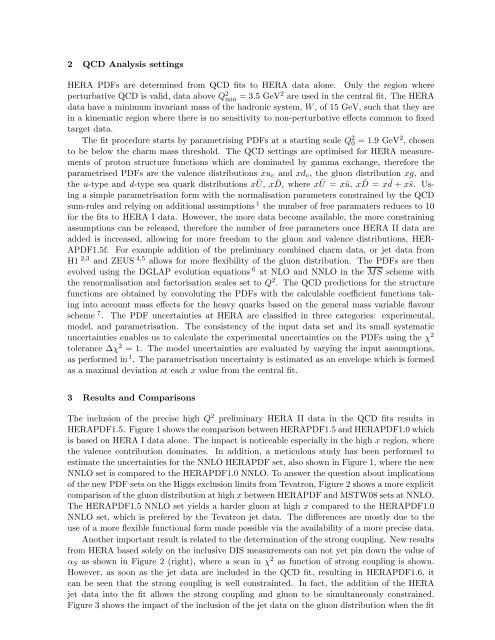2011 QCD and High Energy Interactions - Rencontres de Moriond ...
2011 QCD and High Energy Interactions - Rencontres de Moriond ...
2011 QCD and High Energy Interactions - Rencontres de Moriond ...
Create successful ePaper yourself
Turn your PDF publications into a flip-book with our unique Google optimized e-Paper software.
2 <strong>QCD</strong> Analysis settings<br />
HERA PDFs are <strong>de</strong>termined from <strong>QCD</strong> fits to HERA data alone. Only the region where<br />
perturbative <strong>QCD</strong> is valid, data above Q 2 min = 3.5 GeV2 are used in the central fit. The HERA<br />
data have a minimum invariant mass of the hadronic system, W , of 15 GeV, such that they are<br />
in a kinematic region where there is no sensitivity to non-perturbative effects common to fixed<br />
target data.<br />
The fit procedure starts by parametrising PDFs at a starting scale Q 2 0 = 1.9 GeV2 , chosen<br />
to be below the charm mass threshold. The <strong>QCD</strong> settings are optimised for HERA measurements<br />
of proton structure functions which are dominated by gamma exchange, therefore the<br />
parametrised PDFs are the valence distributions xuv <strong>and</strong> xdv, the gluon distribution xg, <strong>and</strong><br />
the u-type <strong>and</strong> d-type sea quark distributions x Ū, x ¯ D, where x Ū = xū, x ¯ D = x ¯ d + x¯s. Using<br />
a simple parametrisation form with the normalisation parameters constrained by the <strong>QCD</strong><br />
sum-rules <strong>and</strong> relying on additional assumptions 1 the number of free paramaters reduces to 10<br />
for the fits to HERA I data. However, the more data become available, the more constraining<br />
assumptions can be released, therefore the number of free parameters once HERA II data are<br />
ad<strong>de</strong>d is increased, allowing for more freedom to the gluon <strong>and</strong> valence distributions, HER-<br />
APDF1.5f. For example addition of the preliminary combined charm data, or jet data from<br />
H1 2,3 <strong>and</strong> ZEUS 4,5 allows for more flexibility of the gluon distribution. The PDFs are then<br />
evolved using the DGLAP evolution equations 6 at NLO <strong>and</strong> NNLO in the MS scheme with<br />
the renormalisation <strong>and</strong> factorisation scales set to Q 2 . The <strong>QCD</strong> predictions for the structure<br />
functions are obtained by convoluting the PDFs with the calculable coefficient functions taking<br />
into account mass effects for the heavy quarks based on the general mass variable flavour<br />
scheme 7 . The PDF uncertainties at HERA are classified in three categories: experimental,<br />
mo<strong>de</strong>l, <strong>and</strong> parametrisation. The consistency of the input data set <strong>and</strong> its small systematic<br />
uncertainties enables us to calculate the experimental uncertainties on the PDFs using the χ 2<br />
tolerance ∆χ 2 = 1. The mo<strong>de</strong>l uncertainties are evaluated by varying the input assumptions,<br />
as performed in 1 . The parametrisation uncertainty is estimated as an envelope which is formed<br />
as a maximal <strong>de</strong>viation at each x value from the central fit.<br />
3 Results <strong>and</strong> Comparisons<br />
The inclusion of the precise high Q 2 preliminary HERA II data in the <strong>QCD</strong> fits results in<br />
HERAPDF1.5. Figure 1 shows the comparison between HERAPDF1.5 <strong>and</strong> HERAPDF1.0 which<br />
is based on HERA I data alone. The impact is noticeable especially in the high x region, where<br />
the valence contribution dominates. In addition, a meticulous study has been performed to<br />
estimate the uncertainties for the NNLO HERAPDF set, also shown in Figure 1, where the new<br />
NNLO set is compared to the HERAPDF1.0 NNLO. To answer the question about implications<br />
of the new PDF sets on the Higgs exclusion limits from Tevatron, Figure 2 shows a more explicit<br />
comparison of the gluon distribution at high x between HERAPDF <strong>and</strong> MSTW08 sets at NNLO.<br />
The HERAPDF1.5 NNLO set yields a har<strong>de</strong>r gluon at high x compared to the HERAPDF1.0<br />
NNLO set, which is prefered by the Tevatron jet data. The differences are mostly due to the<br />
use of a more flexible functional form ma<strong>de</strong> possible via the availability of a more precise data.<br />
Another important result is related to the <strong>de</strong>termination of the strong coupling. New results<br />
from HERA based solely on the inclusive DIS measurements can not yet pin down the value of<br />
αS as shown in Figure 2 (right), where a scan in χ 2 as function of strong coupling is shown.<br />
However, as soon as the jet data are inclu<strong>de</strong>d in the <strong>QCD</strong> fit, resulting in HERAPDF1.6, it<br />
can be seen that the strong coupling is well constrainted. In fact, the addition of the HERA<br />
jet data into the fit allows the strong coupling <strong>and</strong> gluon to be simultaneously constrained.<br />
Figure 3 shows the impact of the inclusion of the jet data on the gluon distribution when the fit








![List of participants 27/2/09 [pdf] - Rencontres de Moriond - IN2P3](https://img.yumpu.com/17975746/1/190x135/list-of-participants-27-2-09-pdf-rencontres-de-moriond-in2p3.jpg?quality=85)







